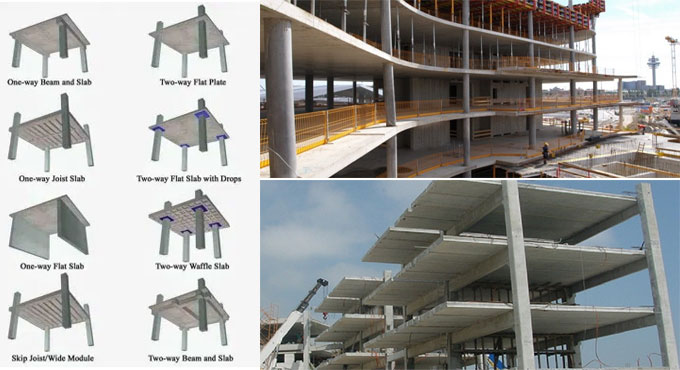
Reinforcement of Concrete Slabs
The determination of a formwork framework ought to be made based on the chosen ?oor framework that satis?es the basic stacking conditions. Floor slabs in concrete structures are classi?ed into two essential sorts, in view of the heap appropriation applied on the Reinforced Concrete slab:
Two-way slab, in which the rectangularity proportion (slab length/width) is somewhere in the range of 1 and 2, and the slab load is moved to the supporting pillars in two directions.Two-way development incorporates ?at plate, ?at slab, waf?e slab, and two-way slabs bolstered by drop shafts.
Single direction slab, in which the rectangularity proportion (slab length/width) is more than 2, and the slab load is moved to the supporting bars a single way. Single direction development as a rule remembers strong slabs for shafts or dividers, single direction joist (ribbed) slabs upheld on bars or bearing dividers.
Two-Way Flat Plate: Such slabs might be cantilevered at the outside of the structure to allow the utilization of outside balconies.The supporting segments for ?at plates are normally similarly dispersed to encourage the plan and development of such slabs.
This framework is prudent for ranges of up to 23 ft (7.0 m) with mellow reinforcing.Flat plates can be built in least time since they use the easiest conceivable formwork. Level plates have been utilized effectively in multi storey inn, lodging, medical clinic, and high rises.
Two-Way Flat Slab: A ?at slab basic framework comprises a steady thickness of Reinforced Concrete slab with drop boards at the sections areas. Note that the framework is normally appropriate for square or about square boards.
In prior years, section capitals were utilized alongside drop boards, but since of the higher formwork cost, segment capitals are less preferred in the present development practice. Level slabs are utilized to oppose heavier burdens and longer ranges than ?at plates. Generally, the framework is generally appropriate for square or about square boards.
Time to Removal of Formwork:
Waf?e Slab: It comprises lines of concrete joists at right edges to strong heads at the columns.Waf?e slabs can be utilized for ranges up to around 50 ft (15.2 m) are utilized to allure the roof.
Two-Way Slab Supported by Beams: This framework comprises a strong slab intended to length in two ways, to either concrete pillars or walls.The essential bit of leeway of the framework is the sparing in fortifying steel and slab segment because of having the option to exploit two-way activity. Formwork for the two-way framework is entangled and for the most part exceeds the cost points of interest related with the sparing in strengthening steel and slab thickness.
Single direction Slab, Beam, and Girder: This framework comprises a strong slab, traversing to concrete bars which are consistently divided. The pillars, thus, are upheld by supports at right points to the shaft to convey loads into the columns.This framework by and large gives the chance to traverse longer separations than two-path by structuring further bars and braces.
Single direction Slab Supported by Beams or Bearing Walls: This framework is a modi?cation of the slab, shaft, and support system.It takes out the auxiliary beams.Reinforcing steel is moderately straightforward, and presence of openings is commonly not a basic concern.
Single direction Joist (Ribbed) Slab: Single direction joist slabs are a solid mix of consistently separated shafts or joists and a slight cast set up slab to shape a necessary unit. At the point when the joists are equal, it is alluded to as single direction joist construction.Joists are exceptionally appealing to engineering format and mechanical supportive networks.


